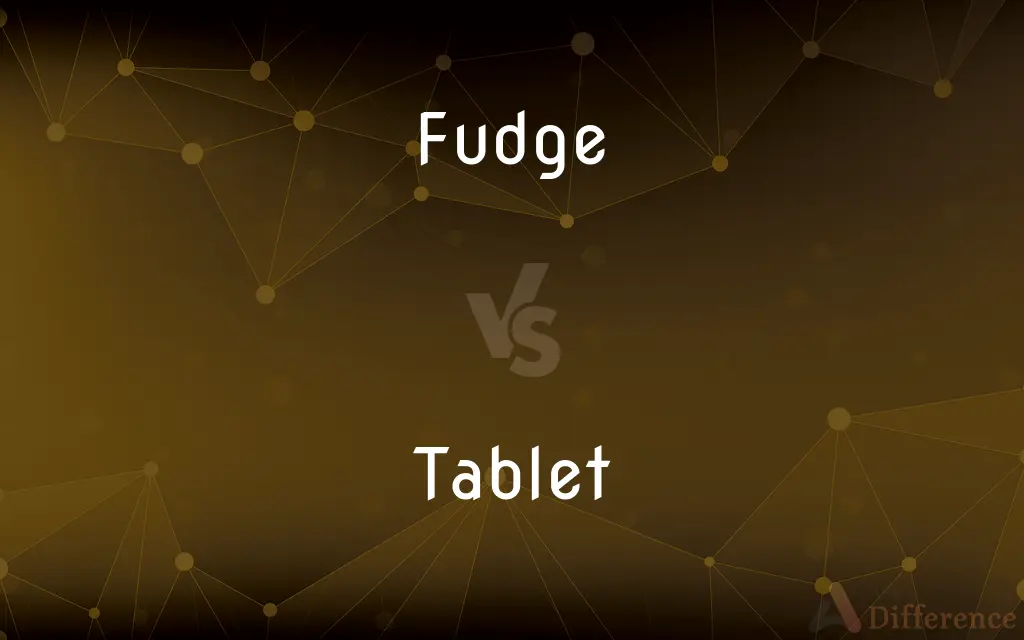Fudge vs. Tablet — What's the Difference?
Edited by Tayyaba Rehman — By Fiza Rafique — Published on March 1, 2024
Fudge is a soft, creamy confection made from sugar, butter, and milk, often flavored with chocolate, while tablet is a grainy, harder Scottish candy made from sugar, condensed milk, and butter.

Difference Between Fudge and Tablet
Table of Contents
ADVERTISEMENT
Key Differences
Fudge and tablet are both sweet confections that have sugar, butter, and milk as their base ingredients, but their textures and preparation methods differ significantly. Fudge is known for its smooth, creamy consistency, achieved by mixing sugar, butter, and milk (or cream) and heating them to the soft-ball stage before beating the mixture as it cools to create a soft, dense texture. It often includes flavors such as chocolate, vanilla, or nuts.
Tablet, a traditional Scottish candy, is grainier and more brittle than fudge. It's made by boiling sugar, condensed milk, and butter to a higher temperature than fudge, then allowing it to crystallize during the cooling process without beating as vigorously as fudge. This results in a firmer and more crumbly texture. Tablet is typically flavored with vanilla or whisky.
The key difference in flavor and texture between fudge and tablet comes from their cooking temperatures and the cooling process. Fudge is cooked to the soft-ball stage (around 234-240°F), while tablet is cooked to a higher temperature, then beaten less to encourage a grainy texture. This makes fudge creamier and softer, while tablet has a distinctive grainy texture and a firmer bite.
Another difference is in their traditional flavors and additives. Fudge often includes a variety of mix-ins such as nuts, chocolate, or fruits, which contribute to its rich flavor profile. Tablet, on the other hand, is usually kept simple, with its primary flavor coming from the caramelized sugar and butter, sometimes enhanced with vanilla or whisky.
In terms of geographic popularity, fudge is widely enjoyed in the United States and across many parts of the world, often found in candy stores and gift shops, particularly in tourist areas. Tablet, while gaining international recognition, remains a distinctly Scottish treat, deeply rooted in Scottish tradition and often homemade or purchased at local bakeries and markets in Scotland.
ADVERTISEMENT
The choice between fudge and tablet may come down to personal preference for texture and sweetness. Fudge offers a smoother, creamier experience with a variety of flavors, while tablet provides a unique, crumbly texture with a rich, buttery taste that's less commonly found outside of Scotland.
Structured Compa
Comparison Chart
Base Ingredients
Sugar, butter, milk/cream
Sugar, condensed milk, butter
Texture
Soft, creamy, and smooth
Grainy, firm, and crumbly
Cooking Temperature
Soft-ball stage (234-240°F)
Higher than fudge, encouraging crystallization
Flavors
Chocolate, vanilla, nuts, and more
Typically vanilla or whisky, less variety
Origin
United States and other regions
Scotland
Popularity
Widely popular internationally
Primarily in Scotland, with some international recognition
Preparation
Beaten as it cools to create a creamy texture
Beaten less to encourage a grainy texture
Consistency
Dense and moist
Dry and more brittle
Sweetness
Very sweet, with varied flavor profiles
Intensely sweet with a buttery, caramelized flavor
Compare with Definitions
Fudge
A creamy confection made by mixing sugar, butter, and milk, flavored with chocolate.
The chocolate fudge melted in her mouth with its rich, creamy texture.
Tablet
A grainy, hard Scottish candy made from sugar, condensed milk, and butter.
After dinner, they enjoyed a piece of traditional Scottish tablet.
Fudge
Often includes nuts or fruit for added texture and flavor.
He preferred walnut fudge for its crunchy texture.
Tablet
Has a crumbly texture that distinguishes it from other candies.
The tablet crumbled deliciously with each bite, revealing its grainy texture.
Fudge
Known for its soft, melt-in-your-mouth quality.
The homemade vanilla fudge was so soft, it seemed to dissolve on the tongue.
Tablet
Often flavored with vanilla or whisky for a distinctive taste.
The whisky-flavored tablet was a hit at the Scottish-themed party.
Fudge
Served in small squares, it's a popular gift item.
She bought a box of fudge to give as a holiday present.
Tablet
A cherished recipe passed down through generations in Scotland.
Her grandmother's tablet recipe was a closely guarded family secret.
Fudge
Requires careful temperature control for perfect consistency.
Making fudge at home, they used a candy thermometer to ensure it didn't overcook.
Tablet
Celebrated for its rich, buttery flavor and firm bite.
The rich, buttery flavor of the tablet made it impossible to have just one piece.
Fudge
A soft rich candy made of sugar, milk, butter, and chocolate or cocoa.
Tablet
A small flat cake of a prepared substance, such as soap.
Fudge
A similar candy made with other flavorings
Peanut butter fudge.
Tablet
(Scotland) A confection made from sugar, condensed milk and butter, produced in flat slabs, with a grainer texture than fudge.
Fudge
Having pieces of fudge candy as an ingredient.
Tablet
A flattish cake or piece; as, tablets of arsenic were formerly worn as a preservative against the plague.
Fudge
A type of very sweet candy or confection, usually made from sugar, butter, and milk or cream.
Have you tried the vanilla fudge? It's delicious!
Tablet
A small flat compressed cake of some substance;
A tablet of soap
Fudge
(US) Chocolate fudge.
Fudge
A kind of soft candy composed of sugar or maple sugar, milk, and butter, and often chocolate or nuts, boiled and stirred to a proper consistency.
Common Curiosities
Can fudge and tablet have the same flavors?
While both are sweet, fudge often has a wider range of flavors, including chocolate, whereas tablet is traditionally vanilla or whisky-flavored.
What makes fudge different from tablet?
Fudge is creamy and smooth, while tablet is grainy and firm, due to differences in cooking temperatures and methods.
Is fudge easier to make than tablet?
Both require precise temperature control, but fudge may be slightly more forgiving due to its creamy texture.
Can fudge be made without chocolate?
Yes, fudge can be flavored with a variety of ingredients, not just chocolate.
Why is tablet grainy?
Tablet's grainy texture comes from boiling it to a higher temperature and the crystallization process during cooling.
Is tablet only found in Scotland?
Tablet is a Scottish specialty, though it can be found in some specialty shops internationally or made at home using traditional recipes.
Which is sweeter, fudge or tablet?
Both are very sweet, but the texture of tablet might make it seem richer in flavor.
Can you add nuts or fruits to tablet?
Traditionally, tablet is kept simple, but modern variations may include such additives for texture and flavor.
How do you store fudge and tablet?
Both should be stored in airtight containers, but fudge may require refrigeration in warm climates to maintain its texture.
Are there regional variations of fudge and tablet?
Fudge has many regional variations in flavor and additions, while tablet variations are more focused on flavoring than texture.
Why is the cooking temperature important in making fudge and tablet?
The temperature affects the sugar's crystallization, which in turn influences the texture and consistency of the final product.
Why might someone prefer tablet over fudge?
Preference for tablet could come from its unique texture and rich, buttery flavor that differs from the creaminess of fudge.
Is one healthier than the other?
Both are high in sugar and fat, making them treats to enjoy in moderation rather than for health benefits.
How long does it take to make fudge compared to tablet?
Both candies require similar preparation times, but cooling and setting times can vary.
Can diabetics enjoy fudge or tablet?
Due to their high sugar content, both should be consumed cautiously by diabetics or those watching their sugar intake.
Share Your Discovery

Previous Comparison
Coyote Tracks vs. Wolf Tracks
Next Comparison
Impulsive Thoughts vs. Intrusive ThoughtsAuthor Spotlight
Written by
Fiza RafiqueFiza Rafique is a skilled content writer at AskDifference.com, where she meticulously refines and enhances written pieces. Drawing from her vast editorial expertise, Fiza ensures clarity, accuracy, and precision in every article. Passionate about language, she continually seeks to elevate the quality of content for readers worldwide.
Edited by
Tayyaba RehmanTayyaba Rehman is a distinguished writer, currently serving as a primary contributor to askdifference.com. As a researcher in semantics and etymology, Tayyaba's passion for the complexity of languages and their distinctions has found a perfect home on the platform. Tayyaba delves into the intricacies of language, distinguishing between commonly confused words and phrases, thereby providing clarity for readers worldwide.










































